1. EJB components are server-side components
2. EJB components contain business logic only – no system-level programming & services, such as transactions, security, life-cycle, threading, persistence, etc. are automatically managed for the EJB component by the EJB server.
- EJB architecture is inherently transactional, distributed, portable multi-tier, scalable and secure.
- EJB components are fully portable across any EJB server
- Instantiation of EJB is handled by container
- Container determines when and how many
- Lifecycle of an instance is managed by container
- EJB instance access is controlled by container
- There is no direct client access
How EJB Invocation happens?
1. Retrieve Home Object reference from Naming Service via JNDI.
2. Return Home Object reference to the client.
3. Create me a new EJB Object through Home Object interface.
4. Create EJB Object reference from the Ejb Object.
5. Return EJB Object reference to the client.
6. Invoke business method using EJB Object reference.
7. Delegate request to Bean (Enterprise Bean).
How can I call one EJB from inside of another EJB?
EJBs can be clients of other EJBs. It just works.
Use JNDI to locate the Home Interface of the other bean, then acquire an instance reference, and so forth.
What is an EJB Context?
EJBContext is an interface that is implemented by the container, and it is also
a part of the bean-container contract.
Entity beans use a subclass of EJBContext called EntityContext.
Session beans use a subclass called SessionContext
What is the difference between session and entity beans? When should I use one or the other?
An entity bean represents persistent global data from the database; a session
bean represents transient user-specific data that will die when the user
disconnects (ends his session).
Generally, the session beans implement business methods (e.g. Bank.transferFunds) that call entity beans (e.g. Account.deposit, Account.withdraw)
Does
Stateful Session bean support instance pooling?
Stateful Session Bean conceptually doesn’t have instance pooling.
Can
I map more than one table in a CMP?
No, you cannot map more than one table to a single CMP Entity Bean. CMP has
been, in fact, designed to map a single table
 |











Session façade.
Calling entity bean indirectly via session bean is called as session façade.














|
Scope |
Name pattern |
|
Global |
java:global[/<app-name>]/<module-name>/<bean-name>[!<fully-qualified-interface-name>] |
|
Application |
java:app/<module-name>/<bean-name>[!<fully-qualified-interface-name>] |
|
Module |
java:module/<bean-name>[!<fully-qualified-interface-name>] |
CustomerServiceLocal customerService =
(CustomerServiceLocal) new InitialContext().lookup("java:module/CustomerService");
java:global/Working-with-EJB3-Tutorials/EJB3/HelloWorld!com.saravan.tutorials.ejb3.HelloWorld
java:global/Working-with-EJB3-Tutorials/EJB3/HelloWorld
java:app/EJB3/HelloWorld!com.saravan.tutorials.ejb3.HelloWorld
java:app/EJB3/HelloWorld
java:module/HelloWorld!com.saravan.tutorials.ejb3.HelloWorld
java:module/HelloWorld
2003 –



|
MANDATORY |
If the client has not started a transaction, an exception is thrown. Otherwise the client's transaction is used. |
|
REQUIRED |
If the client has started a transaction, it is used. Otherwise a new transaction is started. (this is the default when no explicit type has been specified) |
|
REQUIRES_NEW |
If the client has started a transaction, it is suspended. A new transaction is always started. |
|
NOT_SUPPORTED |
If the client has started a transaction, it is suspended. No new transaction is started. |
|
SUPPORTS |
If the client has started a transaction, it is used. Otherwise, no transaction is used. |
|
NEVER |
If the client has started a transaction, an exception is thrown. No new transaction is started. |
|
EJB2 |
EJB3+ |
|
Deployment descriptors (DD) |
Annotation |
|
Home and Remote interfaces |
Not required |
|
ejbPassivate, ejbActivate, ejbLoad, ejbStore, methods |
Not required |
|
JNDI or DD |
POJO and entity manager |
|
|
entity beans/JPA becomes local. Remote annotations are not at all supported for entity beans.
|
|
|
no need to implement container call back methods like ejbActivate() |
|
|
Query is very flexible. Multiple levels of joins are enabled through the refined EJB-QL
|
|
|
Easy to convert from DAO to Entity bean |
|
|
The business interface does not need to extend the EJBObject or theEJBLocalObject interface; |
|
Need EJB container |
It can run JVM without EJB container |
|
|
|
|
|
|
 |
 |
 |




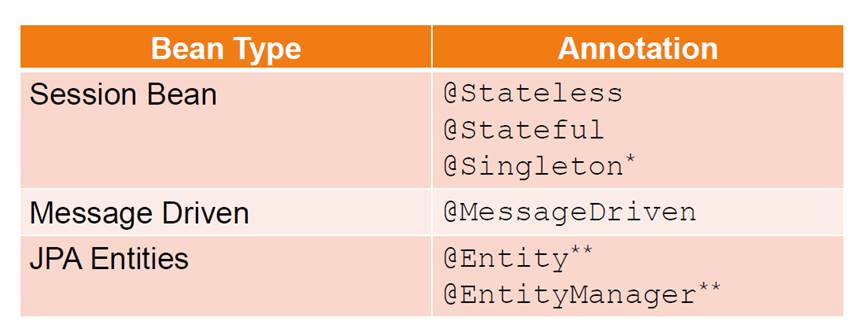

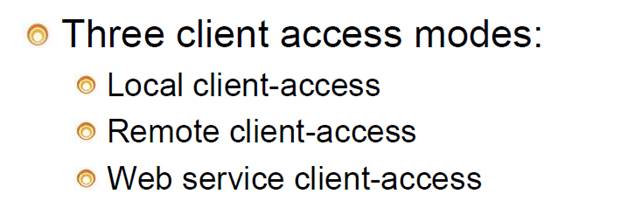


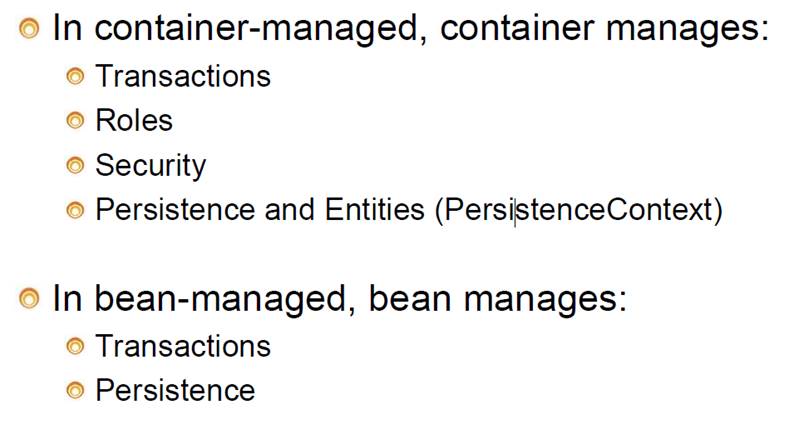
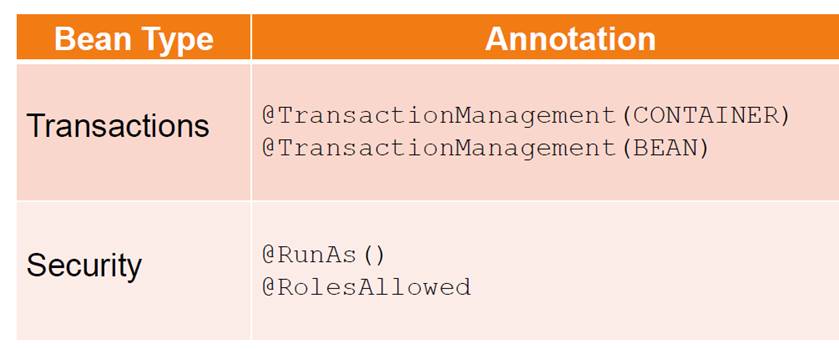
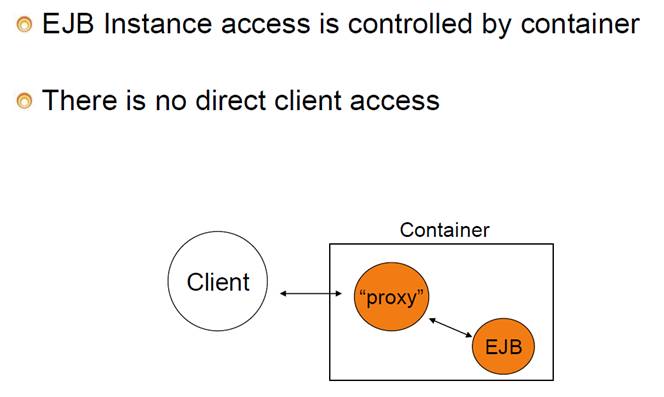


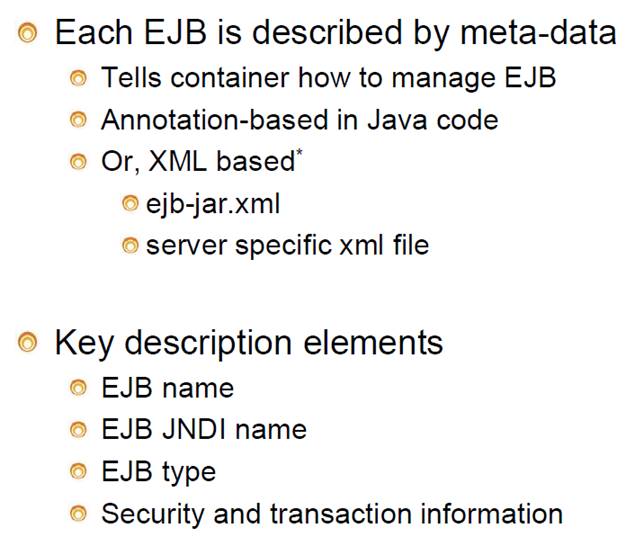

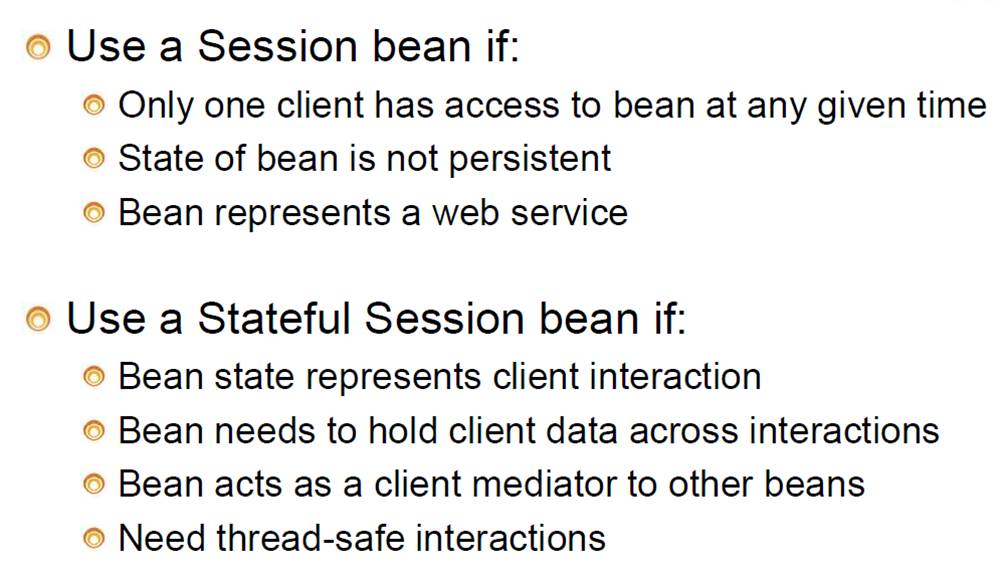
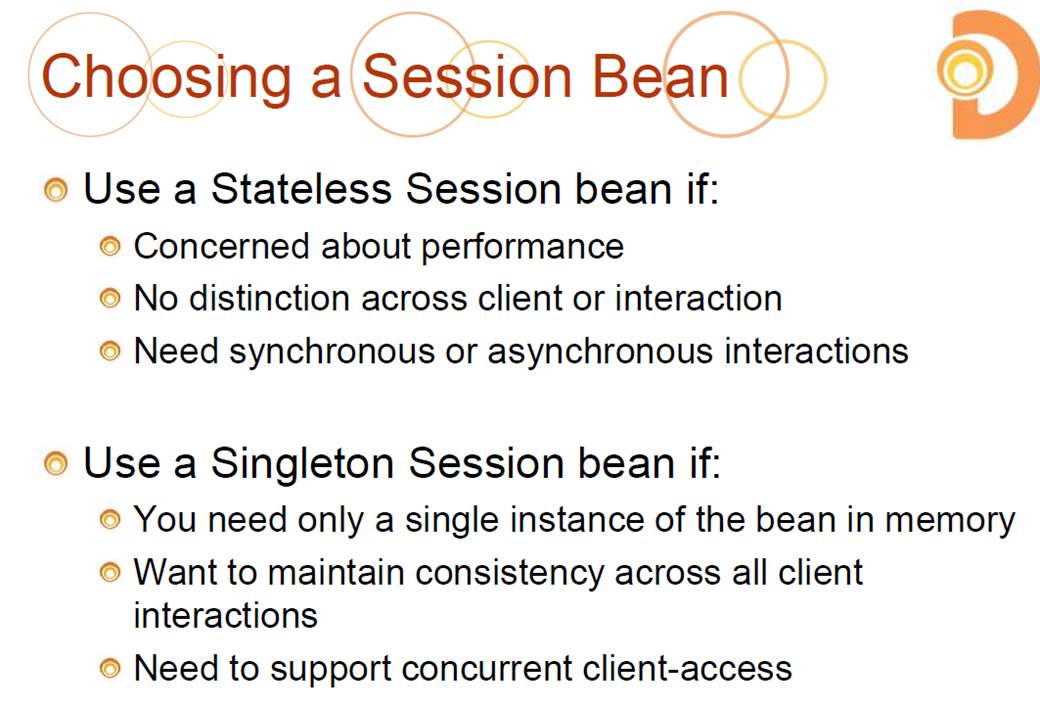
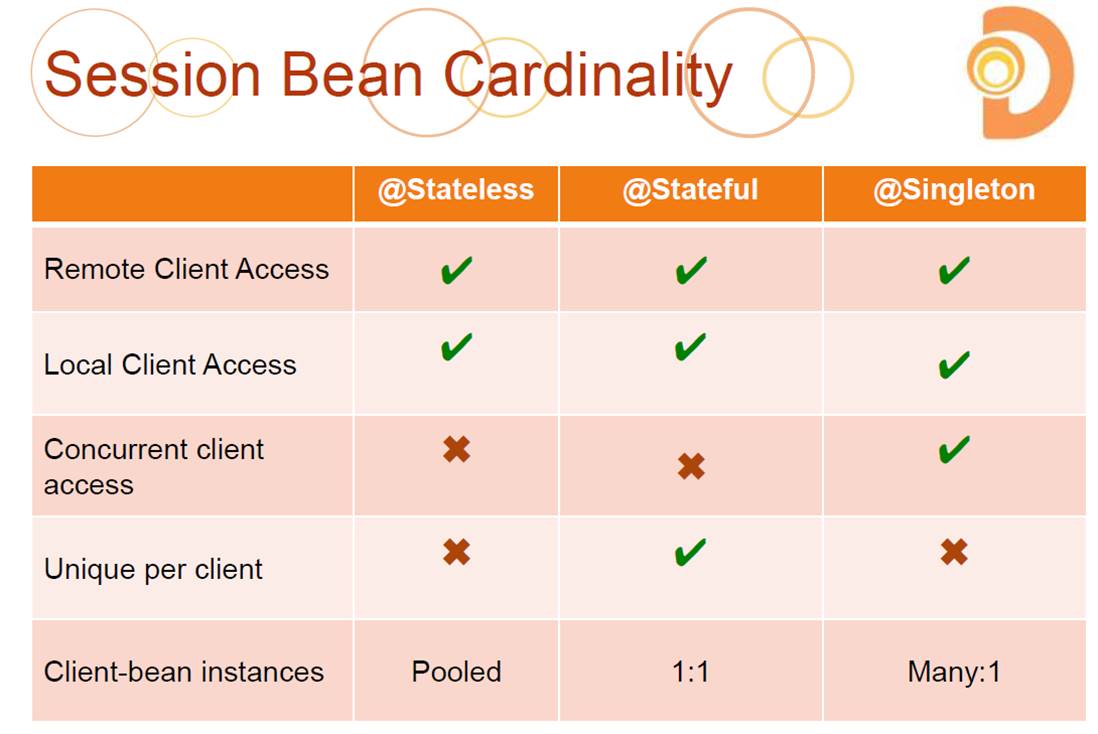

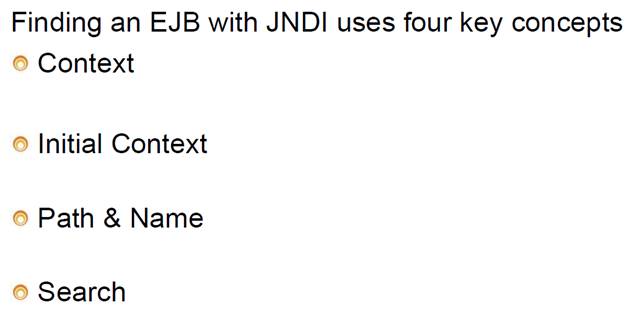
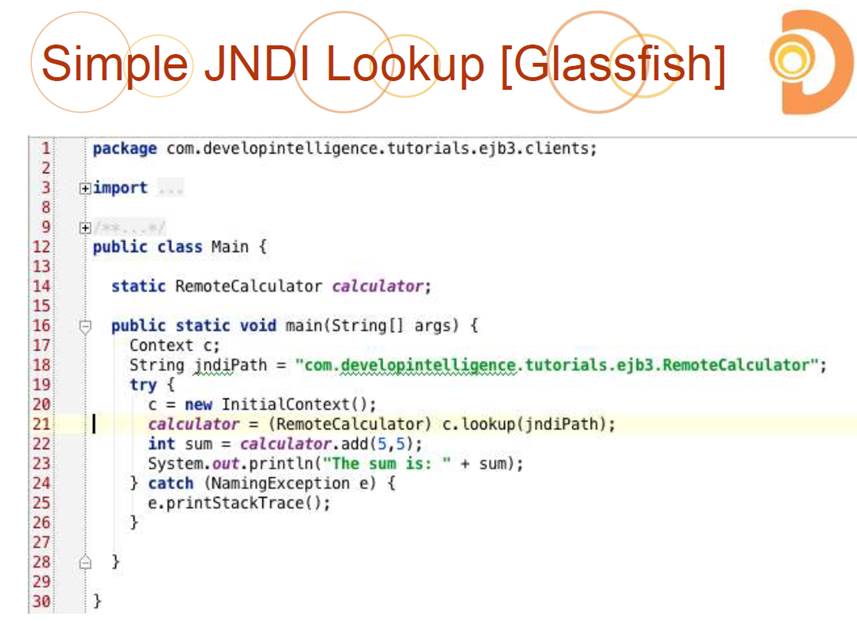
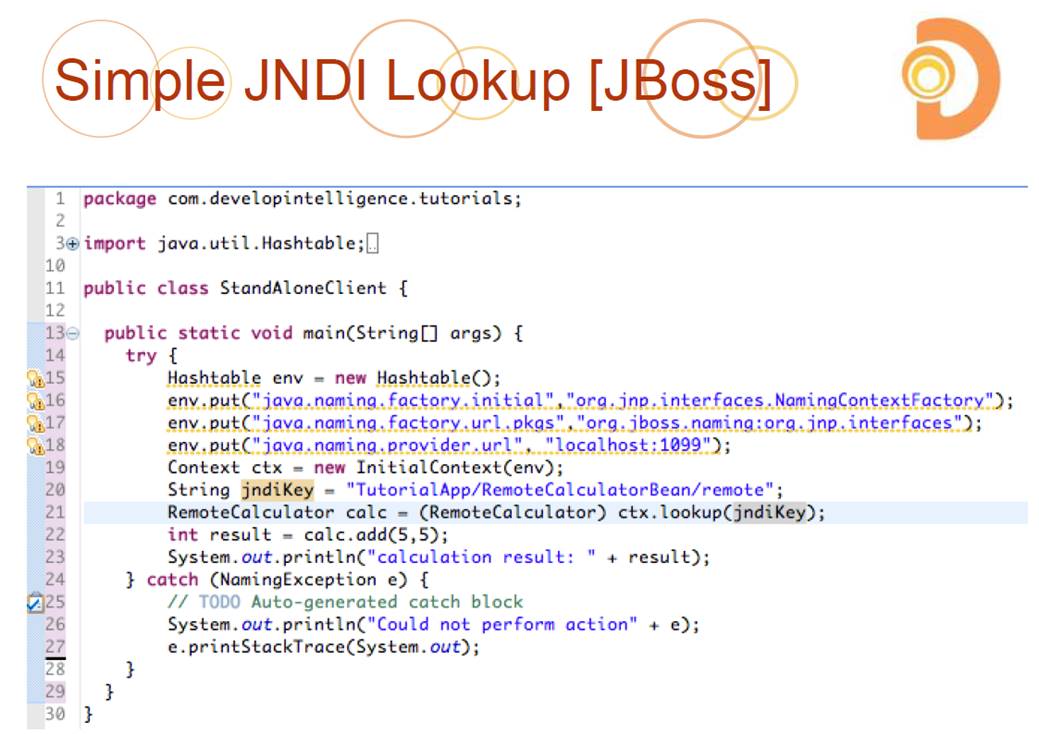

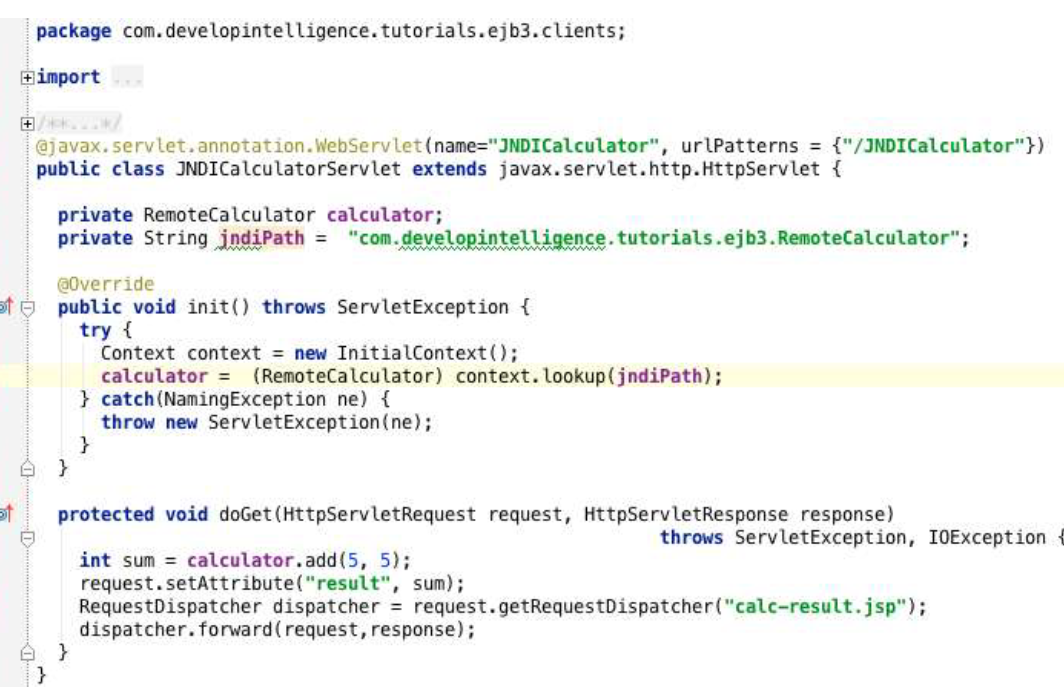
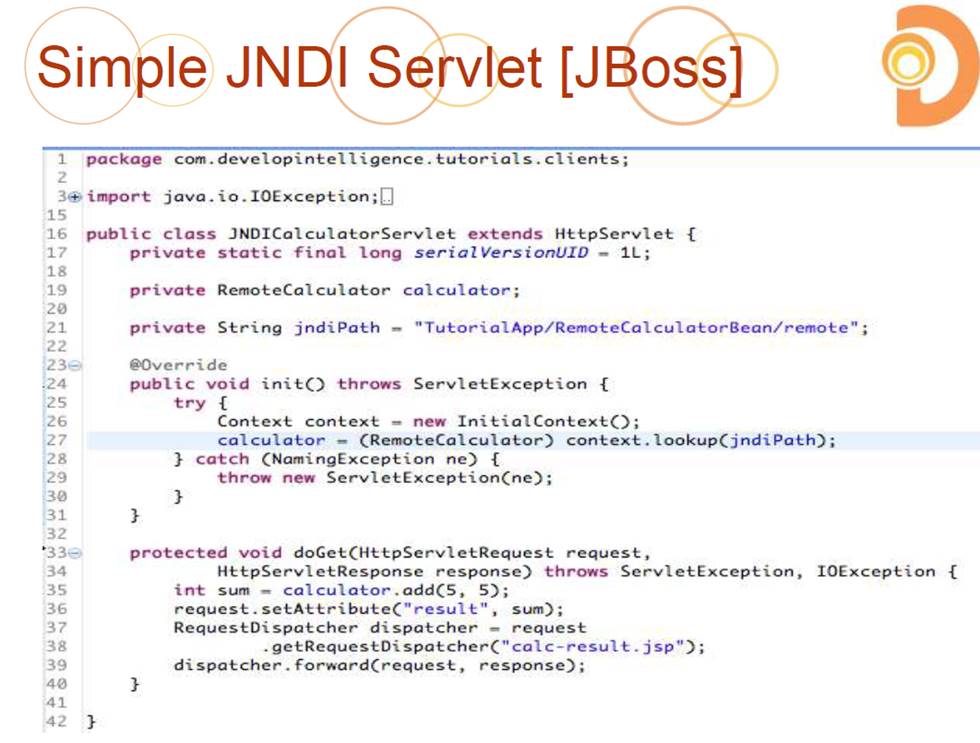

In-Container DI [EJB -> Servlet DI]
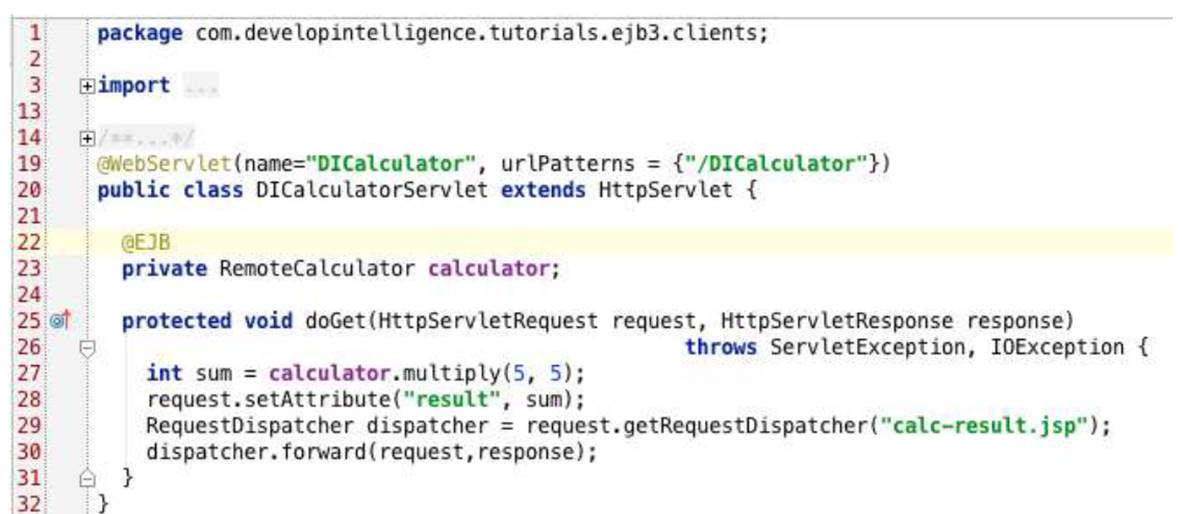
Session Façade Implementation
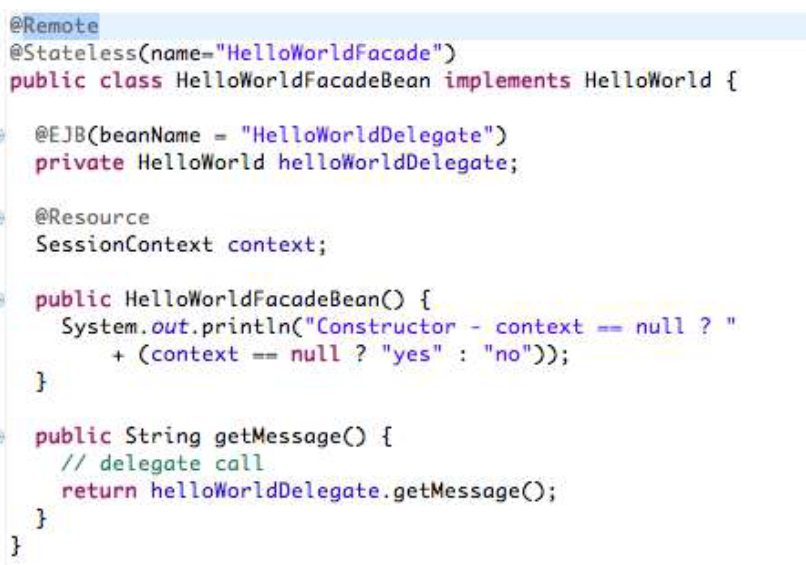
Façade Delegate
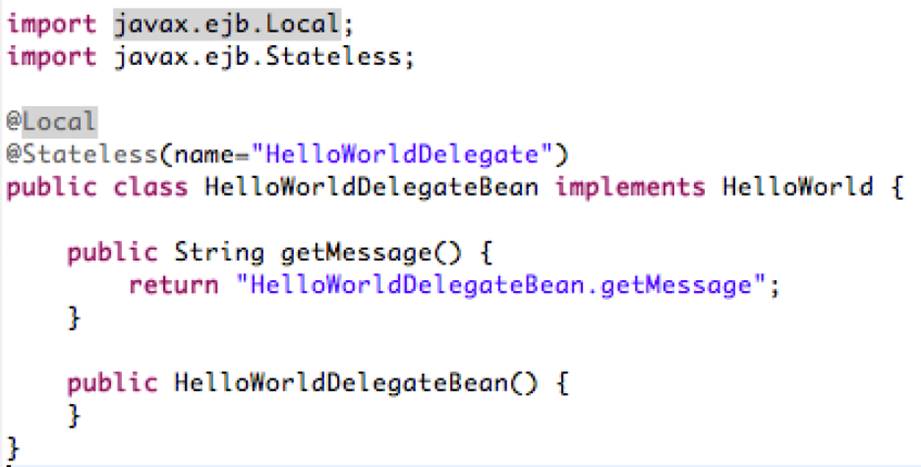
Stateless session bean identity
@EJB MyBean bean1;
@EJB MyBean bean2;
if(bean1.equals(bean1)) // true
if(bean1.equals(bean2)) //true
Stateful session bean identity
@EJB MyBean bean1;
@EJB MyBean bean2;
if(bean1.equals(bean1)) // true
if(bean1.equals(bean2)) //false
Singleton session bean identity
@EJB MyBean bean1;
@EJB MyBean bean2;
if(bean1.equals(bean1)) // true
if(bean1.equals(bean2)) //true
Eager Initialization using @Startup
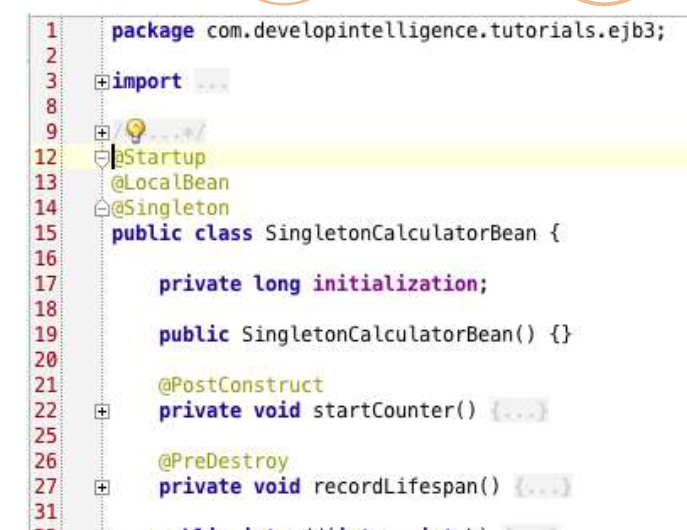
Key Messaging Concepts
Message – encapsulates data passed during
communication
Message Producer – creator of the message
Messaging System – responsible for routing and
delivery of message
Destination – delivery endpoint for message
Message Consumer – end recipient of message
A message contains:
Header fields: priority, timestamp, etc.
Optional message body
Optional properties
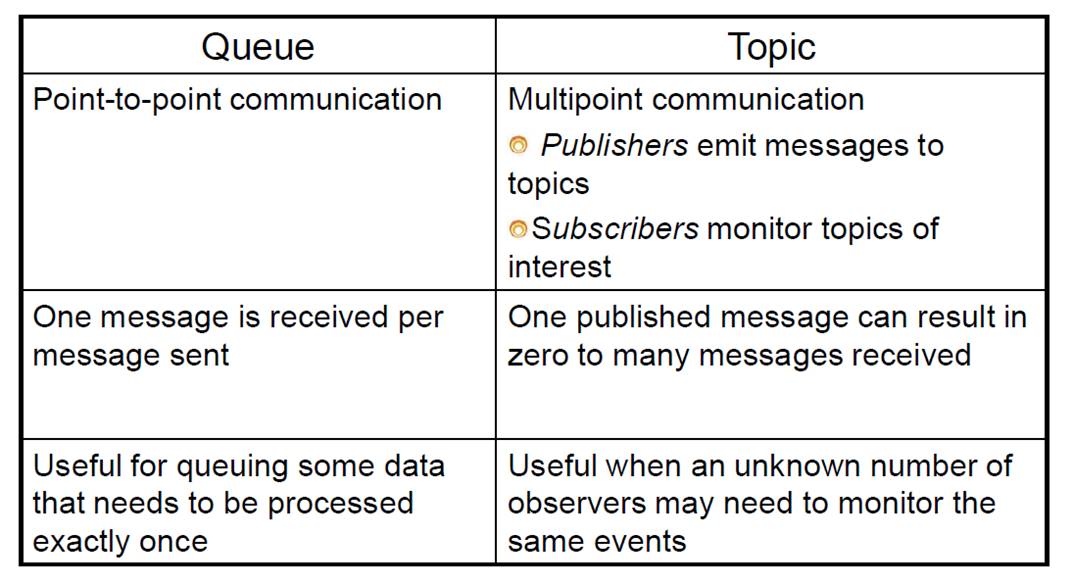
JMS Destination
javax.jms.Destination
javax.jms.Queue
javax.jms.Topic
Dependency Injection examples:
@Resource(mappedName="jms/Queue")
private Queue queue;
@Resource(mappedName="jms/Topic")
private Topic topic;
@Resource(mappedName="jms/Queue")
private Destination topic;
JMS Connection
javax.jms.Connection - physical
connection to the underlying JMS
implementation
Connections are retrieved through a
javax.jms.ConnectionFactory
Two types of connection factories:
javax.jms.QueueConnectionFactory
javax.jms.TopicConnectionFactory
Getting a JMS Connection
@Resource(mappedName="jms/ConnectionFactory")
private ConnectionFactoryconFactory;
Connection con = conFactory.createConnection();
con.close();
JMS Session
Session session = con.createSession(txn-support, acknowledgement);
Sessions support transactions
Transacted (true): messages are not sent until the session
closes
Not transacted (false): messages are sent immediately
Session support acknowledgement
AUTO_ACKNOWLEDGE
CLIENT_ACKNOWLEDGE
DUPS_OK_ACKNOWLEDGE
MessageProducer
javax.jms.MessageProducer
Associated with a specific Destination
Created from Session
MessageProducer producer = session.createProducer(destination);
MessageProducer producer = session.createProducer(queue);
MessageProducer producer = session.createProducer(topic);
Used to send messages to a Destination
producer.send(message);
Message
javax.jms.Message described by:
· Header – name-value pairs used by messaging
system and message consumer
· Properties – name-value pairs to specify
additional information
· Body – payload of the message
· Type - of message being transported
Common Message Header Fields
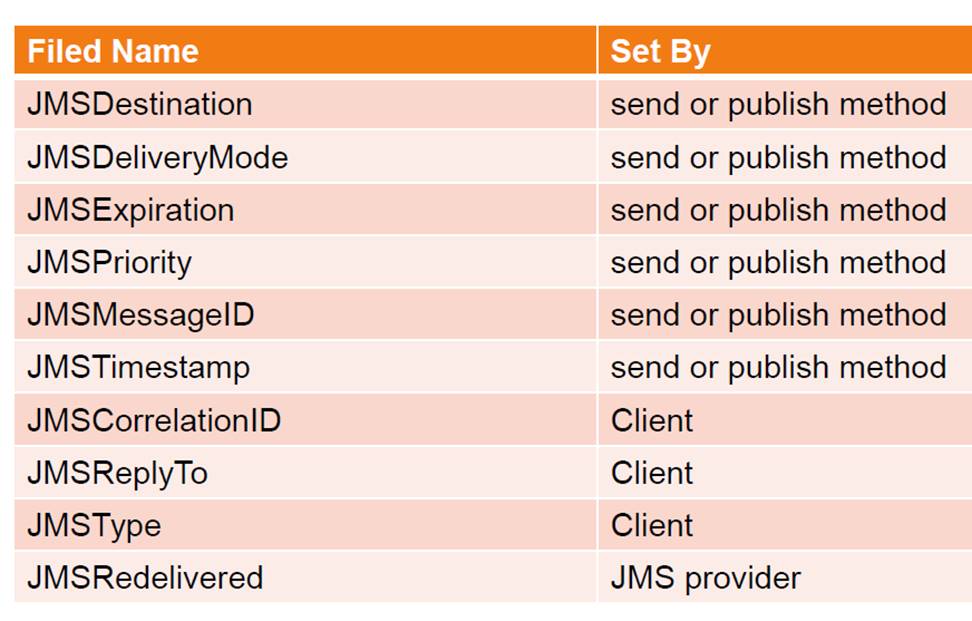
Message Types
\

Message Type Contents of Body
TextMessage message = session.createTextMessage();
message.setText(“Hello Messaging World”);
producer.send(message);
Creating a Message Producer
Steps to create a Message Producer
1. Create Destination in Messaging System
2. Create Client
1. Get Destination
2. Create Connection
3. Create Session
4. Create MessageProducer
5. Create Message
6. Send Message
7. Close Session
8. Close Connection
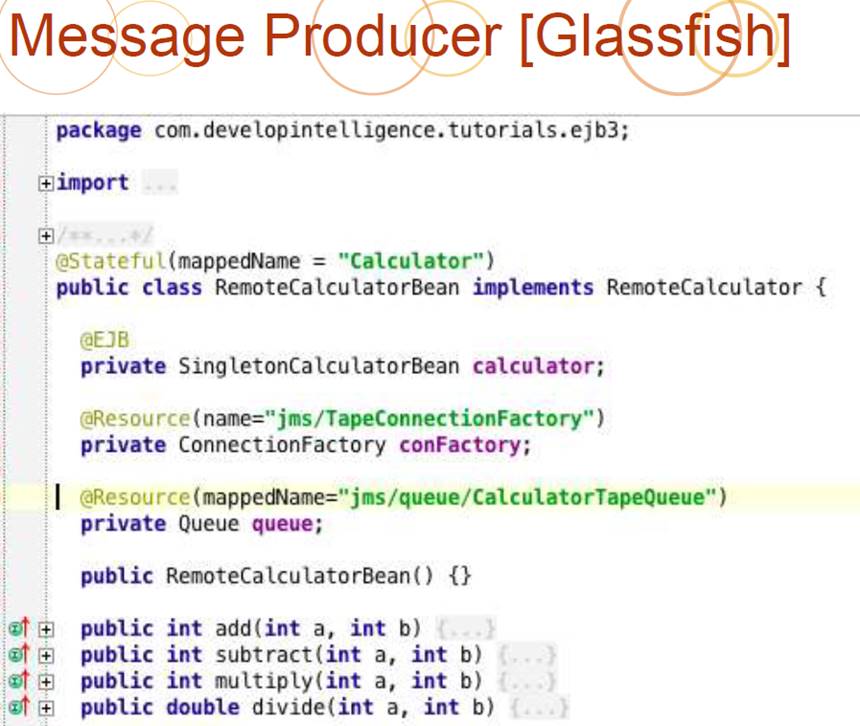
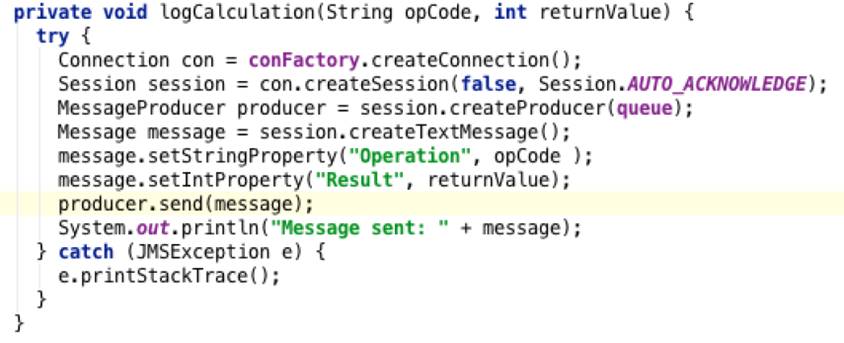
6 Key Concepts in JMS Solutions
Message Producer
Message System
Message Consumer
Message
Destination
Session
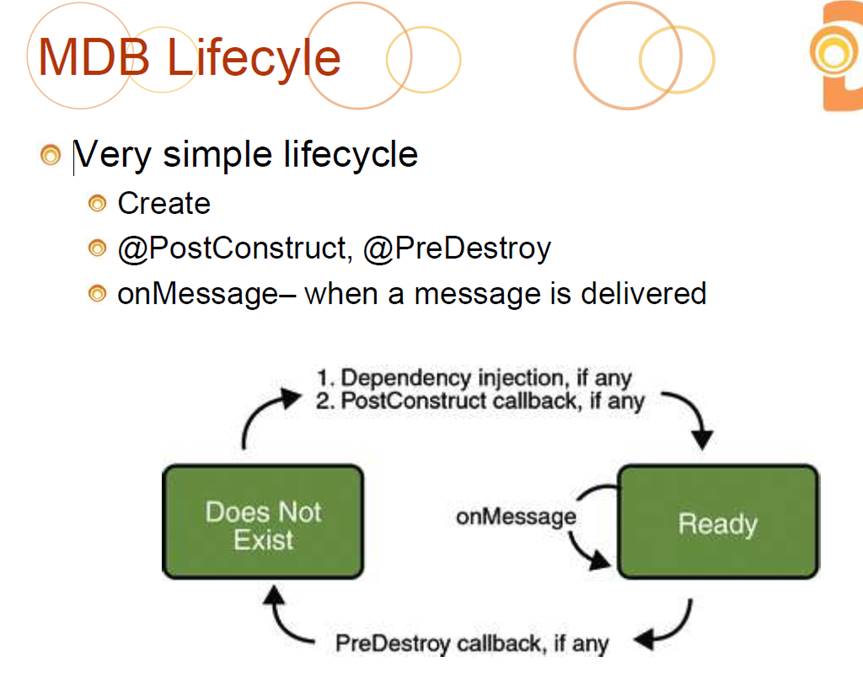
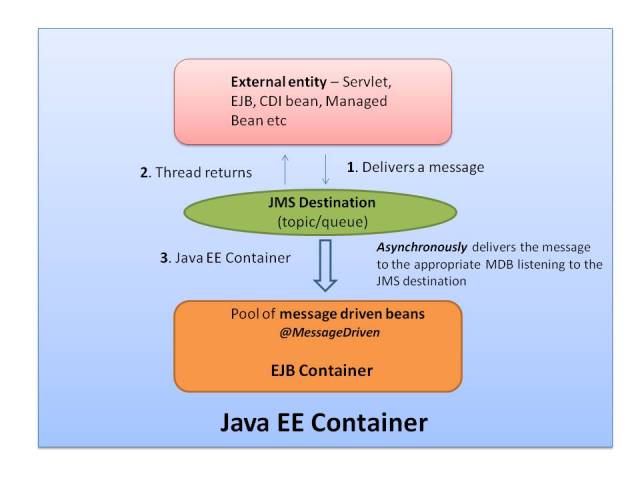
Inheritance Based Example
import javax.ejb.*;
import javax.jms.*;
@MessageDriven
public class MyMDB implements MessageListener {
public void onMessage(Messagemsg) {
System.out.println("Got message!");
}
}
Annotation Based Example
import javax.ejb.*;
import javax.jms.*;
@MessageDriven(messageListenerInterface=javax.jms.MessageListener.class)
public class MyMDB {
public void onMessage(MessageinMessage) {
System.out.println("Got message!");
}
}
Simple configuration
@MessageDriven(mappedName = "jms/HelloMDBQueue”)
Complete configuration
@MessageDriven(activationConfig =
{@ActivationConfigProperty(
propertyName="destination",
propertyValue = "jms/HelloMDBQueue"),
@ActivationConfigProperty(
propertyName="destinationType”,
propertyValue = "javax.jms.Queue")
}
)
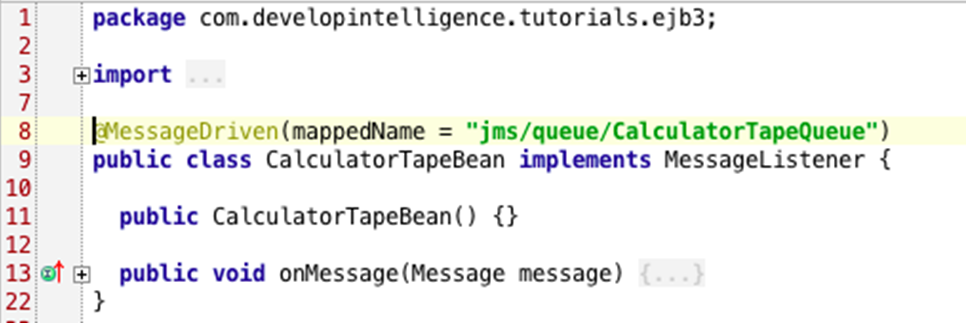
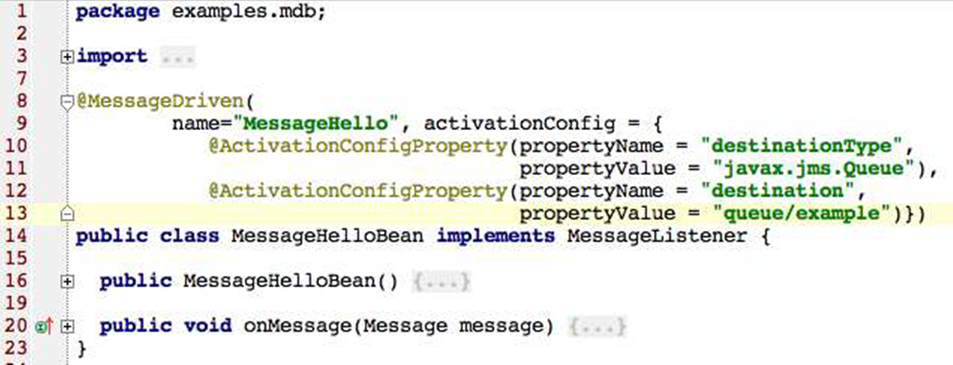

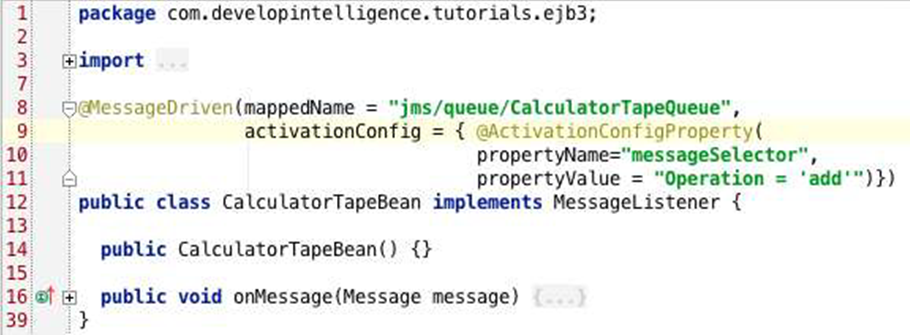
Message Selector Identifiers
Potential identifiers for a message selector
· JMS Headers
· JMSDeliveryMode
· JMSPriority
· JMSMessageID
· JMSTimestamp
· JMSCorrelationID
· JMSType
JMS Properties
setStringProperty, setBooleanProperty,setIntProperty, etc.
Common comparison operators:
Algebraic comparison operators
LIKE operator
BETWEEN operator
IN operator
NOT operator
IS NULL operator
Message Selector Examples
Only add operations
ActivationConfigProperty(propertyName="messageSelector",
propertyValue = "Operation = 'add‘}
Only multiply operations with a result equal to100
ActivationConfigProperty(propertyName="messageSelector",
propertyValue = "Operation = ‘multiply‘ AND Result = 100}
Only multiply or add operations with a result greater than 100
ActivationConfigProperty(propertyName="messageSelector",
propertyValue = "Operation IN (‘multiply‘,‘add‘) AND Result > 100}
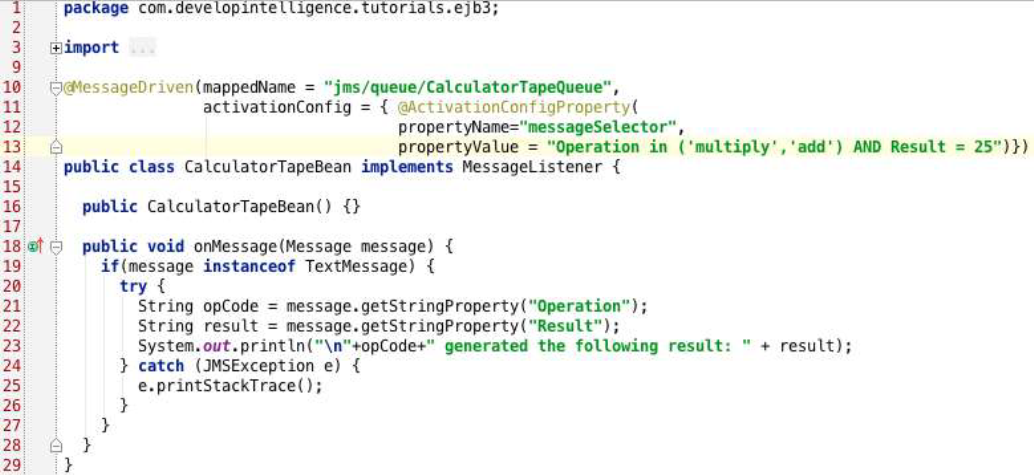
Default – AUTO_ACKNOWLEDGE
Non-Default Example:
@MessageDriven( activationConfig={
@ActivationConfigProperty(
propertyName=”acknowledgeMode”,
propertyValue=“Dups-ok-acknowledge)
}
)
Simplest way to implement an MDB
· @MessageDriven(mappedName=queue/Example
· implements MessageListener
· onMessage(Messagem)
Managing Singleton Concurrency
Aspect-Oriented Programming with Interceptors
EJB Transactions
EJB Security
Web Service Development using EJBs
@Lock
Used to define method-level locking strategies
· Bean can have a concurrent-safe methods
· Or, concurrent unsafe methods
· Or, a mixture of the two
Locking strategy is applied using:
· @LOCK(LockType.READ) – supports concurrency
· @LOCK(LockType.WRITE) – does not support concurrency
Locking strategy can be applied to:
· Class – defines general locking strategy for all methods
· Method – defines specific locking strategy for method
Singleton Concurrency Example
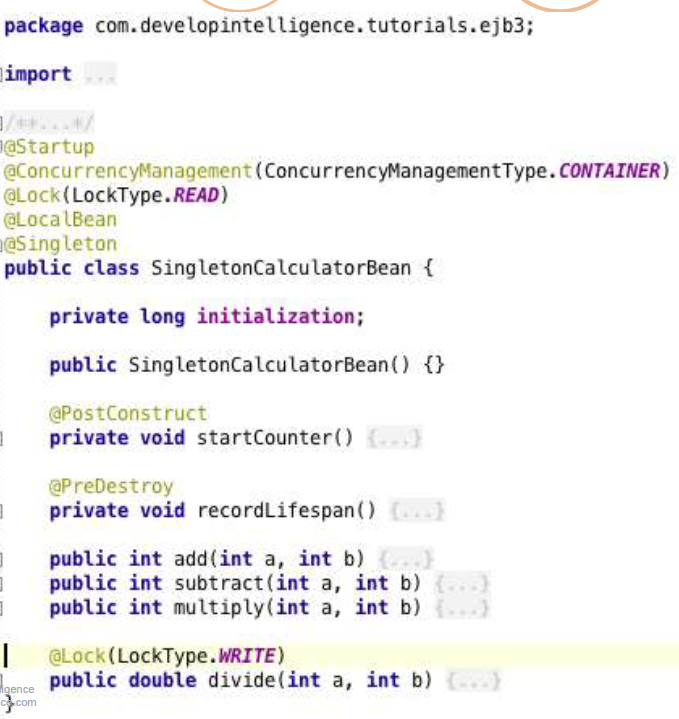
Controlling Dead Lock
· Deadlock - is a situation where in two or more competing
actions are each waiting for the other to finish, and thus
neither ever does
· Deadlock can occur in every concurrent system
· In singletons, may be caused by long-running operations
· Manage wait-times using
![]()
Aspect Oriented Programming
Definition: is a programming paradigm which aims to increase
modularity by allowing the separation of crosscutting concerns
Common cross-cutting concerns:
· Logging, Security
· Validation, Transformation
Advantages of AOP
· Reusability
· Separation of Concern
· Consistency
What is an Interceptor?
Interceptor functionality enables Aspect-oriented
programming within Java EE
Interceptors can be associated with methods or
an entire class
Interceptors intercept interactions with bean
· Can forward the call to the bean
· Can process the call directly
· Can process and forward the call
Interceptor Characteristics
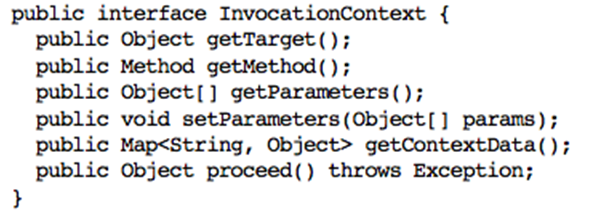
Types of EJB Interceptors
1. Business Method level interceptors
Apply to a single method in a class
Or, apply to all methods in a call
2. Lifecycle Callback Interceptors
3. Timer Timeout Interceptors
Redundant Concern

Refactored Concern
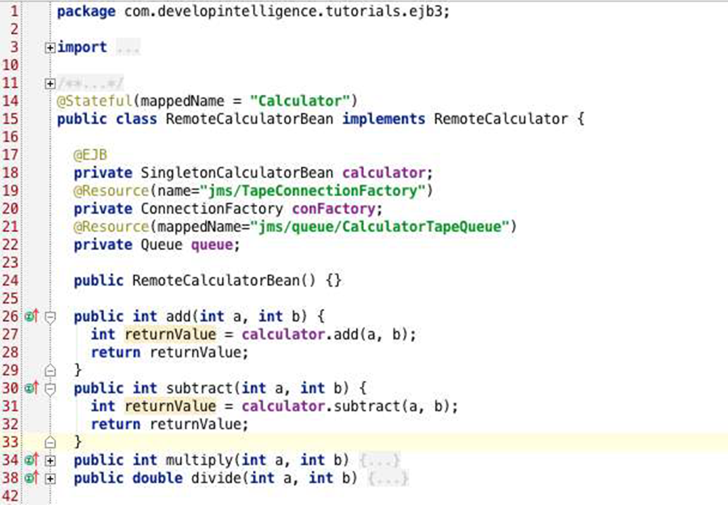
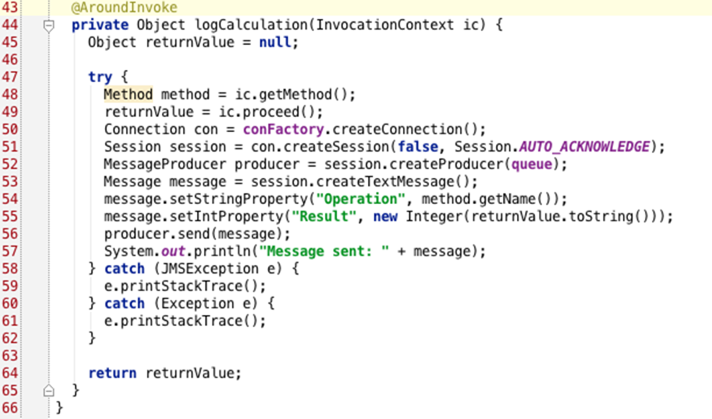
Externalizing the Concern
Better approach is to externalize the concern
Create a class that is an Interceptor
· Declare a Java technology class
· Include a public no-arg constructor
· Declare an interceptor method class
@AroundInvoke
public Object methName(InvocationContextic)throws Exception { . . }
· Invokes the InvocationContextobject‘s proceed
return ic.proceed();
Associate interceptor with EJB
Associating an Interceptor
With a class:
@Stateless
@Interceptors(MyInterceptor.class)
public class MyBean { . . . }
With a specific method
@Stateless
public class MyBean {
@Interceptors(MyInterceptor.class)
public void someMeth() { . . . }
}
EJB with Interceptor Example
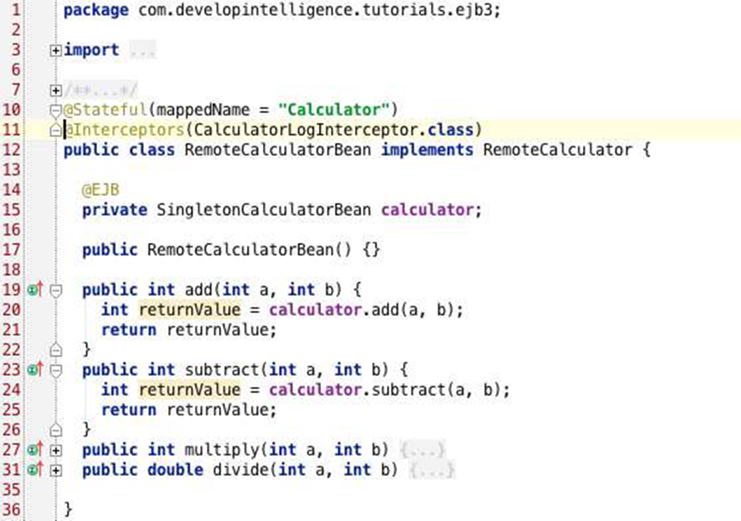
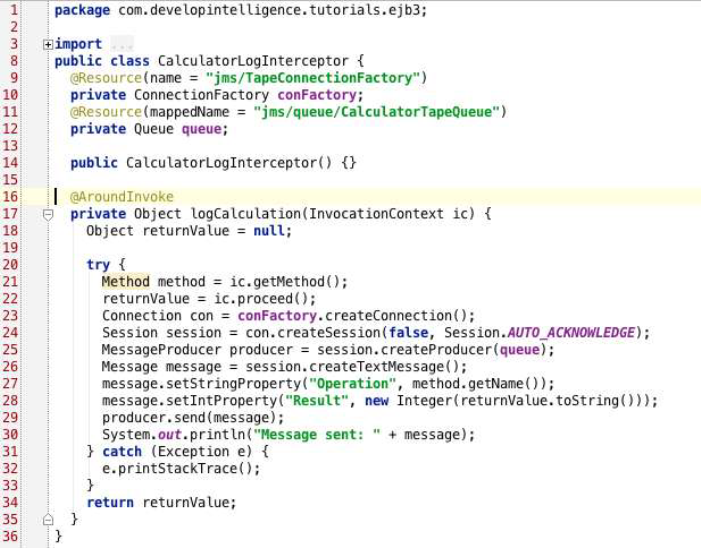
Lifecycle Interceptors

Timeout Interceptors

Class-level interceptors are executed first, then method
level interceptors

LogInterceptor Example
ejb-jar.xml
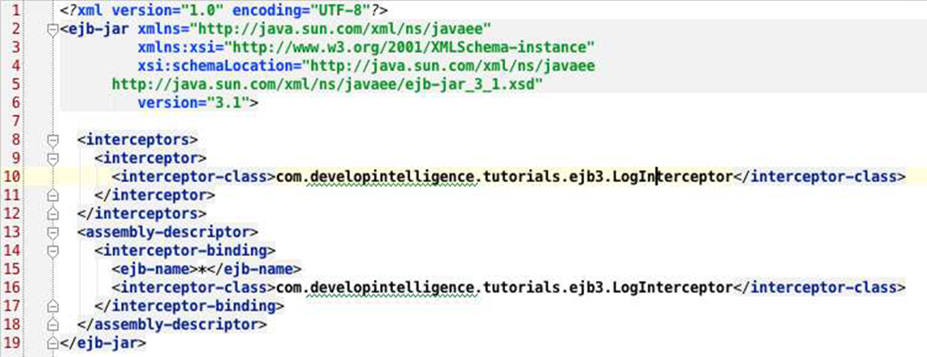
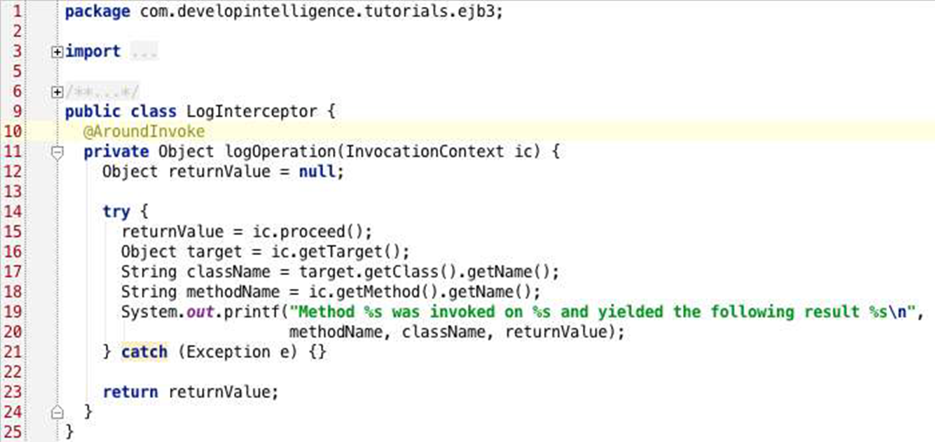
Transactions
Purpose of transactions:
· Treat multiple operations as if they were one
· All succeed together or fail together
ACID of transactions:
· Automicity – all operations succeed or none do
· Consistency – system will be consistent before and after
request
· Isolation – txns are not seen outside of their scope until
completed
· Durability – once a txn successfully completes, client
must commit to its changes
@TransactionManagement(TransactionManagementType.BEAN)
@TransactionManagement(TransactionManagementType.CONTAINER)
· NOT_SUPPORTED – method can not operate correctly
within a txn; container possibly suspends current txn
when performing operation
· SUPPORTS – method can operate correctly within a txn
· REQUIRED – method requires txn, but doesn‘t need to
be new
· REQUIRES_NEW – method requires txn, creates new
txn, possibly suspending current txn until operation
completes
· MANDATORY – method can only operate within txn; if
method is invoked without txn, an exception is generated
· NEVER – method can not operate within txn; if method is
invoked within txn, an exception is generated
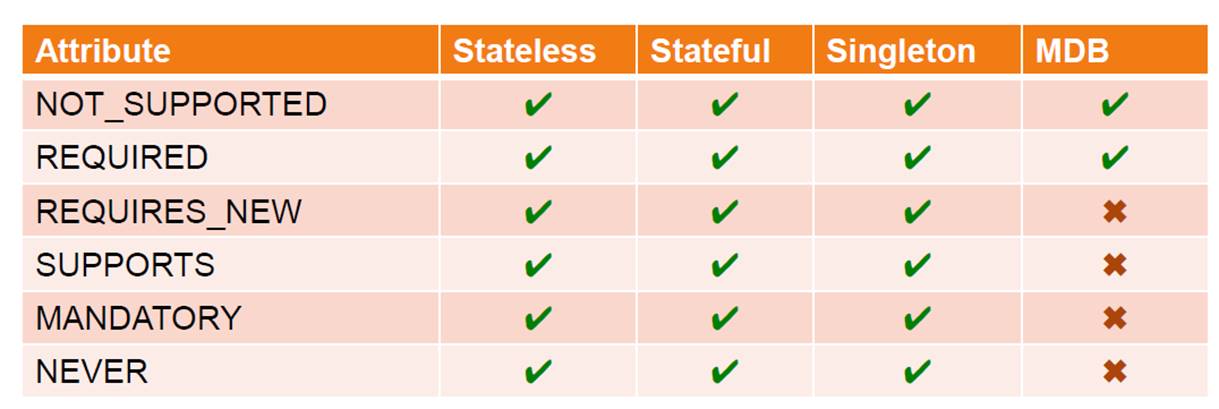
@TransactionAttribute(REQUIRED)
public class MyEJB implements MyI {
}
Method level:
public class MyEJB implements MyI {
@TransactionAttribute(REQUIRED)
public void doSomething() { . . . }
}
JSR250 Security Annotations
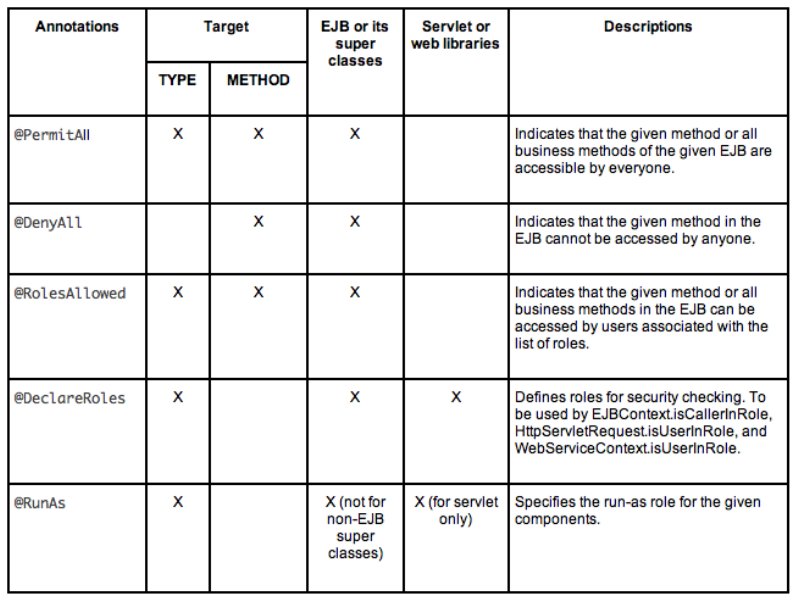
EJB Web Services Support
EJB supports three types of web services:
JAX-RPC
Creates Web Service Endpoints defined by WSDL
Uses SOAP as transport mechanism
JAX-WS
New version of JAX-RPC
Better support for more modern web service
development
JAX-RS
REST-based web services
Simple to implement and use
Two ways to develop web services
Manually assemble web service
o WSDL
o Java Interface
o Bindings
Automatically
o Translate an EJB into a Web Service
o Annotation driven
JAX-WS Web Service Annotations
@WebService
javax.jws.WebService
Apply to EJB class
Exposes all public methods
@WebMethod
javax.jws.WebMethod
Apply to specific methods to expose within bean
SOAP Configuration annotations
@SOAPBinding
@WebParam
@WebResult
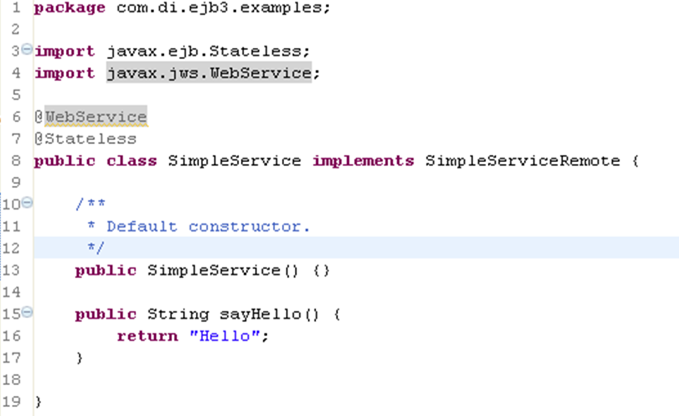
JAX-RS Annotations
@Path – entry point for REST service
HTTP request methods
@Get
@Post
@Put
@Delete
@Produces / @Consumes – data transfers
@Produces(application/xml)
@Consumes(application/xml)
@Produces(application/json)
@Consumes(application/json)
@Produces(text/plain)
@Consumes(text/plain)
Simple REST EJB
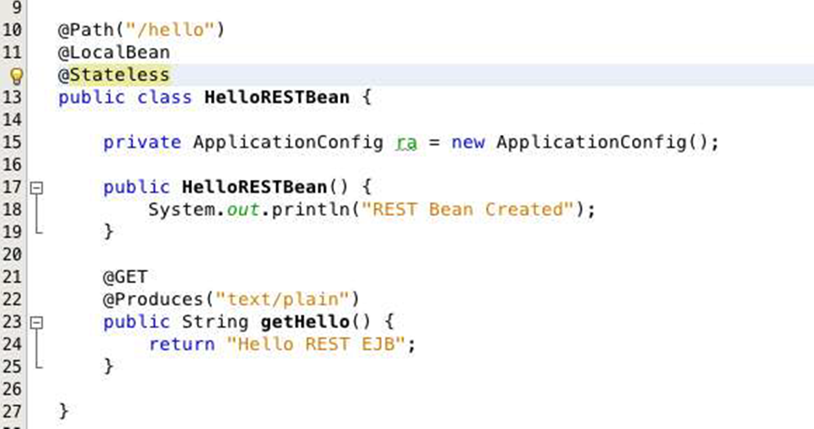
· AOP can be applied using Interceptors
· Transactions can be managed by the container
or the bean
· Java EE is focused on authorization, not
authentication
· Stateless and MDBs can be converted to web
services with the @WebServiceannotation

|
|
JAX-WS |
JAX-RS |
|
|
Soap uses services intrfaces |
URiS |
|
|
Permits XML format |
Lot of formats JSON, XML, HTML, text, RSS, etc |
|
|
It is like envelope |
It is like postcard, so simple |
|
|
Cannot be cached |
Can be cached |
|
|
ENDPOINT |
It supports PUT, DELETE |
|
|
It can be HTTP, TCP or SMTP, FTP, JMS, MIME |
HTTP or HTTPS only |
|
|
It has both stateless and stateful |
It is stateless |
|
|
Supports async |
|
|
|
Security and authorization are part of the protocol |
|
|
|
Enterprise approach |
Open web |
|
|
Used in financial services / payment gateways / telcom services |
Used in social media, web chat, mobile |
Defining Schedules
Schedules consist of 7 attributes:
Time components
second – [0,59]
minute – [0,59]
hour – [0,23]
Calendar components:
dayOfMonth – [1,31], Last, Sun, Mon, Tue, etc.
month – [1,12], Jan, Feb, Mar, etc.
dayOfWeek – [0,7], Mon, Tue, etc.
year – [2001]
Every Tuesday at Midnight
ScheduleExpression schedule = new ScheduleExpression();
schedule.setDayOfWeek(Tue);
schedule.setHour(0);
Every Weekday at 3:15 AM
ScheduleExpression schedule = new ScheduleExpression();
schedule.setDayOfWeek(Mon-Fri);
schedule.setHour(3);
schedule.setMinute(15);
Every 15 minutes of Every Hour Every Day
ScheduleExpression schedule = new ScheduleExpression();
schedule.setHour(*);
schedule.setMinute(*/15);
@Schedule(dayOfWeek=Mon)
public void listOrders(Timer timer) {
// do something fancy
}
